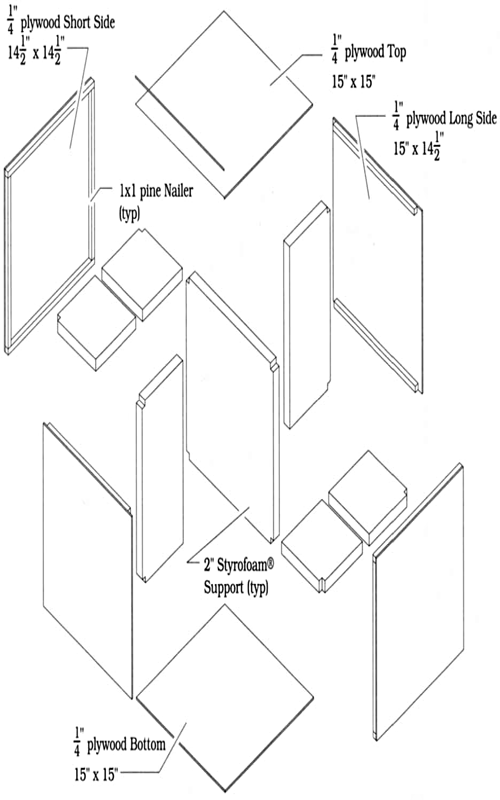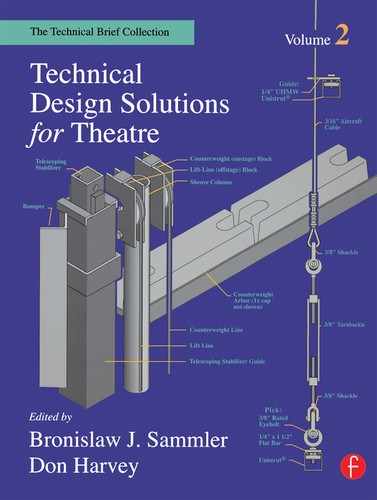Lightweight Acting Cubes |
Fritz Schwentker |
Although adults take the portability of modular set pieces, often known as “acting cubes,” for granted, small children would be hard pressed to maneuver a 15″ cube of standard ¾″ plywood construction. The Seattle Children’s Theater designed a lightweight solution to this problem for the youngest student actors to use in their summer instructional program. A thin plywood shell with a minimal pine frame served to reduce weight, and beadboard supplied intermediate support inside the cubes. The combination of strength and portability was soon appreciated by the adults as well as the kids who used the cubes.

FIGURE 1: CUTAWAY OF 15″ ACTING CUBE (TOP NOT SHOWN)
The cutaway view in Figure 1 shows the construction of a single cube, part of a set designed as a magnified version of a child’s play blocks. Six panels of ¼″plywood liberally glued and bradded to 1×1 nailers form a shell with strong joints. Notched blocks of 2″ beadboard perpendicularly span each opposite pair of cube faces inside the shell. The beadboard proves an ideal material because of its light weight and ability to withstand the compressive load of an adult standing on one of these ¼″ plywood boxes.

FIGURE 2: EXPLODED VIEW OF 15″ ACTING CUBE
The shell of the cube is assembled first, as it is easiest to construct the cube from the outside in. Starting with the beadboard supports requires an awkward glue-up of the beadboard pieces to one another, and can be eliminated by installing them after the plywood panels have been joined. The shell should be built as an open-ended box, with one of the opposing long sides left off to accommodate the seven cuts of beadboard shown in Figure 2. Applying adhesive to each plywood/bead-board and beadboard/beadboard joint guarantees stability of the internal supports. Common construction adhesive serves this purpose well, although the thickness of the glue-line may necessitate some judicious trimming of the beadboard slabs to allow a good fit. During the construction of a second set of cubes at The Children’s Theater, a polyurethane-foam-based adhesive available in spray cans solved the glue-line-thickness problem, but was unfortunately messier. To seal the cube slide the remaining long side into place and nail it home.
A rugged and splinter-free finish is essential given the hard use for which the cubes were designed. After a thorough sanding to round off the sharp corners, the plywood edges and voids at the joints need to be filled. The Children’s Theater shop found Bondo® to be the sturdiest putty in protecting the edges. A final sanding to remove the excess is all that is required to prepare the blocks for a paint finish.
A 15″ cube built from ¾″ plywood weighs approximately 21 pounds. This alternative construction weighs only 9½ pounds: 7 pounds for the plywood; 1 pound for the pine framing; and 1½ pounds for the beadboard supports. Materials for each of the heavier cubes cost approximately $5.80, as compared to $6.50 for the lightweight version. The slightly higher cost and longer construction time, about twice as long, involved in fabricating these lightweight cubes are relatively low if the benefits of portability are desired. It is worth noting that other block configurations are easily adapted from this plan. The Children’s Theater built double (15×l5×30), triple (15×l5×45), and quadruple (15×15×60) blocks, as well as assorted round and triangular shapes for its collection.
Silas Morse at the Seattle Children’s Theater deserves the credit for inspiring this design.
